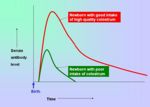Materno-Fetal Immunity - Introduction
Introduction
Passive immunity occurs when 'preformed' antibodies are made in one animal and passed onto another. For example a cow passes on her own antibodies to her calf via colostrum (first milk after parturition) and milk.
Antibodies can be transferred to other individuals via colostrum, milk, crossing of the placenta, vaccination, and plasma transfusions.
Neonates require maternal antibodies because:
1. They have poorly developed immune systems and are immunocompromised at birth.
Lymphocytes in neonates: Increased numbers of mostly mature and functional T and B lymphocytes are found in the blood. However the ability to mount an immune response to certain antigens is absent. This may be due to:
- Immaturity of some cells - T helper cells, B cells and Antigen presenting cells.
- Lack of expression of genes encoding receptors for each antigen.
- The presence of maternal antibody which binds antigen and removes it thus preventing the neonate from developing active immunity.
Antibodies in neonates:
2. Neonatal mucosal surfaces are particularly vulnerable
3. Colostral and milk antibodies protect neonates from infections
Passive transfer via placenta
| SPECIES | PLACENTA TYPE | IgG TRANSFER? |
|---|---|---|
| human | haemochorial | YES |
| dog/cat | endotheliochorial | SMALL AMOUNT |
| horse/ruminant/pig | epitheliochorial | NO |
Due to the placentas of ruminants and horses having 5 tissue layers between the maternal and fetal circulation there is no transfer of antibodies across the placenta.
Passive transfer via colostrum
In the dam B cells migrate from the MALT to the mammary gland where antibodies are secreted into the colostrum and milk.
Colostrum
Colostrum is the pre-milk fluid usually thick and yellow in colour that is secreted from the mammary glands for only a short time after birth by most mammals.
- There is species variation with the composition of colostrum.
- It contains:
- Immune factors - immunoglobulins, lactoferrins, protein-rich polypeptides, leukocytes, cytokines, trypsin and protease inhibitors.
- Growth factors: EgF, IGF-I, IGF-II, FyF, PDGF, TgF A and B and growth hormone (GH) - which aid in rebuilding damaged body systems and stimulating the bodies metabolism to burn fat for energy instead of the bodies own muscle tissue.
- Vitamins and minerals.
- IgG is most abudant in colostrum, followed by IgA and IgM
- During the first 30 hours of life, immunoglobulins are absorbed through the intact jejunum and pass to the lacteals, thoracic duct and into the systemic circulation.
- The first diagram (entitled Transfer of IgG across intestine via FcRn) shows IgG being present in the intestine of a neonate, from the ingestion of colostrum. Fc receptors (FcRn) are present on the surface of the intestinal epithelial cell in neonates for the first 30 hours. The IgG binds to the receptors and is transported through the cell by pinocytosis and released into the lacteals unchanged.
- The capacity for immunoglobulin absorption progressively declines from birth due to the FcRn only being present for a limited period of time. After 6 hours a third of the FcRn are non functional.
- It is essential that all animals with epitheliochorial placentas (ruminants, horses, pigs) receive adequate colostrum intake within the first 4 hours (optimal absorption period) of life because no transfer of immunoglobulins via the placenta can occur.
- The second diagram (entitled Passive Transfer) shows the relationship between passive immunity from the mother and the neonatal production of antibodies.
- Colostrum also provides the neonate with a vital energy source to generate heat and enzymes to aid digestion of colostrum products.
Milk
Milk is the primary source of nutrition for young before they are able to digest other food. In non-ruminants IgA is most abundant, followed by IgG and IgM; IgG is most abundant in ruminant milk.
- Milk has approximately 1/100th of the antibody concentration of colostrum.
- Between colostrum and milk there is a period where a substance similar to them both is secreted called transition milk. By approximately 5-7 days milk is being secreted.
- The capacity for immunoglobulin absorption from the gastrointestinal tract is completely absent 30 hours post partum so the main role of milk (apart from a nutritional source) is to protect the intestinal lining.
- IgA remain in the intestine and attach to the intestinal villi protecting the intestinal lining against enteric pathogens.
| Colostrum source | Acceptability |
|---|---|
| Dam with good quality colostrum | Best source |
| Another female in the flock/frozen colostrum (must be thawed properly) | Best substitute |
| A female in another flock (similar disease status) | Next best substitute |
| Ewe or doe | There is a risk of transferring diseases for example Maedi Visna and Caprine Arthritis and Encephalitis (CAE) viruses. |
| Cow | Lower in nutrition (milk from coloured breeds is higher in fat), need to feed 1/3 more volume, Johne's risk |
| Colostrum supplement powder | Nutritious, contains antibodies, expensive |
| Lamb or kid milk replacer | Only feed after first 24 hours of life as it is not an adequate substitute for colostrum |
References
Books
A.H. Andrewa Bovine Medicine - Diseases and Husbandry of Cattle Blackwell Publishing 2004 2nd Edition
Koterba, Drummound and Kosch Equine Clinical Neonatology Williams and Wilkins 1990
P. Lydyard, A. Whelan and M.W. Fanger Immunology Garland Science 2nd Edition 2004
Websites
www.sheepandgoat.com
| This article has been peer reviewed but is awaiting expert review. If you would like to help with this, please see more information about expert reviewing. |
| Originally funded by the RVC Jim Bee Award 2007 |


